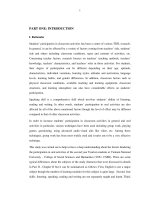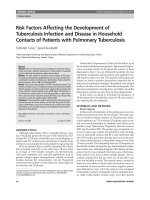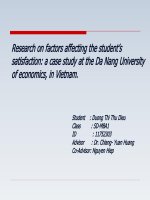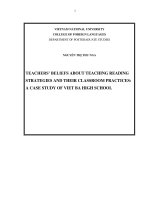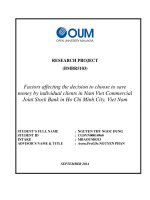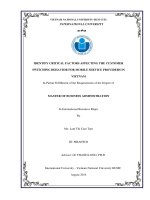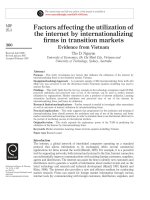Factors affecting the utilization centerin customer service by firms in vietnam market
Bạn đang xem bản rút gọn của tài liệu. Xem và tải ngay bản đầy đủ của tài liệu tại đây (576.34 KB, 83 trang )
UNIVERSITY OF ECONOMICS HO CHI MINH CITY
INTERNATIONAL SCHOOL OF BUSINESS
------------------------
NGUYEN QUOC VIEN
FACTORS AFFECTING THE UTILIZATION OF CALL
CENTERIN CUSTOMER SERVICE BY FIRMS
IN VIETNAM MARKET
MASTER OF BUSINESS (Honours)
Ho Chi Minh City - year 2014
UNIVERSITY OF ECONOMICS HO CHI MINH CITY
INTERNATIONAL SCHOOL OF BUSINESS
------------------------
NGUYEN QUOC VIEN
FACTORS AFFECTING THE UTILIZATION OF CALL
CENTERIN CUSTOMER SERVICE BY FIRMS
IN VIETNAM MARKET
ID: 22110079
MASTER OF BUSINESS (Honours)
SUPERVISOR: Dr. ĐINH THAI HOANG
Ho Chi Minh City - year 2014
ACKNOWLEDGEMENT
During the process of writing my thesis, I had coped with difficulties and obstacle that
I could not anticipate. The pressure of daily work seems to make me give up my study.
However, thanks to the encouraging of my supervisor, Dr. Dinh Thai Hoang, I was received a
great will to overcome step by step the difficulties.
I own my deepest gratitude to my supervisor, Dr. Dinh Thai Hoang, who with his
wide research experience, guided me to complete this topic. Without his continuous support,
encouragement, and enthusiasm, this research would hardly have been completed.
I am indebted to Dr. Nguyen Dinh Tho for his immeasurable amount of teaching and
guidance during the research design course. I would like to thank Ms. Thai Thi Thu Giang,
my friend at University of Economics Ho Chi Minh City, who introduced me the MBUS
course at ISB and encouraged me to go to the end of the course.
I also express my warmest gratitude to my professors at ISB, University of Economics
Ho Chi Minh City for their teaching and guidance during my MBUS course I wish to thank
warmly my classmates who showed their teamwork spirit and willingness to help each other
to complete our theses.
Finally, this thesis is dedicated to my beloved parent and daughter who understand,
encourage, and sympathize with me especially in making the convenient environment during
my work of this dissertation.
1
ABSTRACT
This thesis aims to investigate the factors that affect the utilization of call center in
customer service by firms in Vietnam, especially in Ho Chi Minh City – a biggest and
dynamic center business of Vietnam. Many Vietnamese firms are using the call center as a
tool for their customer service channel; however, the benefits that Vietnamese customer
orientation firms or broader the orientation market firms gain from its customer focus or
market focus through call center system either directly or indirectly remain unknown. The
study uses quantitative research method with the sample size of 230 enterprises including
firms are utilizing the call center for their own, firms are using the call center outsourcing
service and firms have hotline number to serve their customers. The reliability, convergent
and discriminant validity of scales was tested by Cronbach’s Alpha coefficient and
exploratory factor analysis then regression analysis was done to find out the correlation
between the concepts in the theoretical model. This study finds that the key concepts in the
technology acceptance model (TAM), perceived ease of use of the call center, cannot be used
to predict call center utilization by organizations. Other concepts: perceived usefulness of call
center, market orientation and service innovation are predictors of call center utilization.
Learning orientation facilitates market orientation, perceived usefulness and perceived ease
of use of the call center by Vietnamese firms. The result of this research assist in identifying
keys factors that lead Vietnamese firms to adopt using the call center as a tool to take care,
retain their customers and develop market in globalization stage; moreover, this study shows
that both large enterprises and SME also gain the benefits from using call center by choosing
the right form of call center investment; owning a call center or using call center outsourcing.
Keywords: Call center utilization, market orientation, learning orientation, contact
center in Vietnam.
2
CONTENTS
ACKNOWLEDGEMENT ..............................................................................................................1
ABSTRACT.....................................................................................................................................2
LIST OF TABLES AND FIGURES................................................................................................5
CHAPTER 1: INTRODUCTION ....................................................................................................6
1.1. Contact center introduction ..........................................................................................6
1.2. Research background ...................................................................................................7
1.3. Research problem.........................................................................................................8
1.4. Research objective .......................................................................................................9
1.5. Thesis structure ..........................................................................................................10
CHAPTER 2: LITERATURE REVIEW & HYPOTHESES ........................................................11
2.1. Technology Acceptance Model – TAM .....................................................................11
2.2. TAM and contact center utilization ............................................................................12
2.3. Market and learning orientations and intention to adopt call center system...............15
2.4. Service innovation and call center utilization .............................................................18
CHAPTER 3: RESEARCH METHOD .........................................................................................21
3.1. Measurement ...............................................................................................................21
3.2. Quality study ...............................................................................................................23
3.3. The sample ..................................................................................................................24
3.4. Data collection, purifying and coding data .................................................................24
CHAPTER 4: DATA ANALYSIS AND RESULTS ....................................................................26
4.1. Descriptive statistics ...................................................................................................26
4.2. Reliability statistic ......................................................................................................28
4.2.1. Market Orientation Cronbach’s Alpha.........................................................28
a. Customer orientation ..............................................................................28
b. Competitor orientation ...........................................................................29
c. interfunctional coordinator .....................................................................30
3
4.2.2. Learning orientation Cronbach’s Alpha.......................................................31
a. Commitment to learning ........................................................................31
b. Shared vision..........................................................................................32
c. Open mindedness ...................................................................................33
4.2.3. Perceived usefulness of call center ..............................................................33
4.2.4. Perceived easy to use call center ..................................................................34
4.2.5. Service Innovation .......................................................................................35
4.3. Exploratory Factor Analysis (EFA) ............................................................................36
4.3.1. EFA of Market orientation concept ..................................................................36
4.3.2. EFA of Learning orientation ............................................................................37
4.3.3. EFA of Perceived usefulness, Perceived ease of use and Service innovation .39
4.4. Correlations analysis ...................................................................................................41
4.5. Regression Analysis ....................................................................................................42
4.6. Discussion ...................................................................................................................50
CHAPTER 5: CONCLUSION ......................................................................................................54
5.1. Management implication ............................................................................................55
5.2. Limitation and directions for future research..............................................................56
REFERENCE.................................................................................................................................58
APPENDIX 1: Research process ...................................................................................................65
APPENDIX 2: Scale Items ............................................................................................................66
APPENDIX 3: Scale Items refinement ..........................................................................................69
APPENDIX 4: Factor analysis.......................................................................................................72
APPENDIX 5: Regression analysis ...............................................................................................75
APPENDIX 6: The result of qualitative survey.............................................................................77
4
LIST OF TABLES AND FIGURES
Figure 1: Theory of reasoned action ..............................................................................................11
Figure 2: Original technology acceptance model ..........................................................................12
Figure 3: A conceptual model of call center utilization.................................................................19
Figure 4: Model regression results .................................................................................................49
Table -5: Cronbach’s Alpha of three components in Market orientation concept .........................31
Table-10: Cronbach’s Alpha of three components in Learning orientation concept .....................33
Table-28: Correlations (see appendix 4) ........................................................................................74
Table-45: The summary of verifying hypothesis in conceptual model .........................................49
5
CHAPTER 1: INTRODUCTION
1.1. Contact center introduction
Nowadays, people regularly receive calls or messages from the customer service
center of telecommunication companies, banks, insurance organizations, hospitals,
transportation companies, game online companies and consumer firms… or even calls for
telesales and telemarketing. The question is how they can make a lot of calls; send a hundreds
of messages at the same time to their customers, how they can remember all the customer
numbers and detail of each transaction. That is a call center; thus, what is the call center?
As defined by North American Quitline Consortium (NAQC), call center is a place
where contacts are made and received. It is often the “front door” to a business and is the
place where most crucial customer interactions take place. Therefore, its effective and
efficient operation is a key ingredient to the overall success of any organization (NAQC,
2010). There are five main operational functions in any type of call center: workforce
management, quality management, technology management, report and communications and
financial management.
Call centers provide a single contact for customers who may try to reach a company
via multiple channels: e-mail, Web chat, fax, and phone, short message service (SMS) or
VoIP (voice over Internet protocol). Call centers, often called contact centers to reflect the
multiple points of access, provide staff with consistent information throughout an integrated
system; the term call center is used interchangeably with contact center. These centers
capture data from across the enterprise and consolidate customer-related information into a
central database. This integration improves the customer's interaction and satisfaction and
enhances the efficiency of the business operation (Duane Sharp, 2003).
6
Large organizations such as telecommunication companies, insurance and financial
firms may choose to outsource its call center services, as a professional call center will be
able to provide the systems and trained workforce to provide quality service to customers.
1.2. Research background
Vietnam's economic growth rate has been among the highest in the Asia Pacific region in
recent years 2010, 2011, 2012, 2013 respectively 6.4%, 6.2%, 5.2%, 5.2%. Growth in
services eased to 5.9%, this sector still made the largest contribution to GDP growth, at 2.5
percentage points (Dominic Mellor, Chu Hong Minh, and Nguyen Luu Thuc Phuong, 2014).
With customer service becoming a key focus in Asia Pacific, Vietnam is improving customer
relationships for the purpose of greater loyalty, brand recall, and profitability. Adopting using
the call center or call center service is one of the best ways to improve the customer
satisfaction and customer relationship by firms in Vietnam, that’s because there’s a growth in
call center in recent years.
According to Dao Thi Minh Thao, a research associate in the ICT Practice at Frost &
Sullivan APAC, this effort is leading to an impressive growth in Vietnam’s contact center
industry that was estimated to be worth $4.2 million in 2011 and is expected to reach $11.4
million in 2018, with a growth rate of 15 percent. Most contact center projects in Vietnam are
deployed by banks, financial institutions, and telco service providers. These sectors require a
high level of customer care; large seat numbers are needed to always be available to serve
customers. She also commented that “for further growth and success, small and middle-sized
enterprises (SME) should look forward to more efficient contact center application adoption
to align these trends for the future. Emerging global vendors in providing suitable solutions
also need to offer more customized solutions and effective marketing activities at more
affordable price” (Donna Jeremiah, 2012).
7
Realizing the potential and advantages of call center, many researches on call center
and its effectiveness were taken. Most of them focus on the advantages such as customer
satisfaction in using and outsourcing call center and service quality in call center operation.
In researches indicating the advantages of call center, application of the technologies
involved in call center operations can play a key role in accessing more customers, and in
providing better quality services especially where additional or extended services become
available (Walker and Craig-Lees, 1998). However, call center is a new form of technology
in Vietnam; it has just developed in recent years when firms think of customer. There is
almost no theoretical research for this type of service technology; thus this is an opportunity
for this study.
1.3. Research problem
In Vietnam, it’s easy to realize call center is used by most of banks, financial and
insurance firms, telecommunication companies, hospitals, transportation companies, game
online companies and consumer firms…. What are the motivations that lead the firms
choosing the call center as tool for customer service channel? The fact is that there is no
previous studies mention the evolution of the call center, analyzing the technologies that have
contributed to its growth, providing guidelines for the development and implementation of a
call center as well as the management of the facility, and the role of human factors that can
make a call center a successful operation. Especially, there is no empirical research on what
factors effecting the utilization of call center in customer service by firms in Vietnam.
Vietnamese firms just remark the benefits and advantages of using call center through the
trend of customer care service what the other big companies did to retain their customers;
however, these benefits must be deeply based on the orientation of each organization. The
question as regards how Vietnamese customer orientation service firm (large or small firm)
or broader how the Vietnamese orientation market firm (large or small firm) benefits from its
8
customer focus or market focus through call center system either directly or indirectly remain
unknown. This leads to finding the key factors effecting the call center utilization by firms in
Vietnam.
According to (Duane Sharp, 2003), call centers are an essential part of any business
that deals frequently with customer queries. Not only large organizations with huge customer
get the benefits from using call center but SME can also get these benefits by choosing
outsourcing call center services. Building a call center internally may be feasible only for
very large enterprises, smaller companies should consider outsourcing their call centers to
organizations that specialize in providing these services and already have the latest
technologies installed and operating, with trained staff. These organizations can often provide
excellent customer-oriented services, relieving smaller organizations of the financial,
managerial, and human resources issues involved in an internal, corporate call center.
1.4. Research objective
Realizing the potential for firms to use the call center as an effectiveness tool and
convenient customer service channel to serve their customers better and quickly develop the
market and almost no empirical research in call center utilization in Vietnam, this study aim
to fill the gap of lacking the empirical investigation in Vietnam’s call center utilization,
reveal the factors that lead firms to adopt using the call center as a part of their business
activities specifically in Ho Chi Minh city – a biggest and dynamic business center of
Vietnam. Since the research involved the new technology factors and IT system integration,
the Technology Acceptance Model (TAM) (Davis, 1989) is used to predict information
technology usage (Adams et al., 1992; Lucas and Spitler, 1999), this study uses an adapted
version of TAM revised by Tho D. Nguyen (2007) for internet usage by export firms in
transitional markets to explain the extent to which firms in Vietnam market utilize the call
9
center as tools and customer service channels for their business activities, retain their
customers and develop market.
1.5. Thesis structure
This thesis is organized in five chapters: chapter 1 mentions the problem research,
research objective, research scope and research’s reality meaning; chapter 2 is concerned
with literature review and hypotheses; chapter 3 refer to research method; chapter 4 deal with
data analysis, results and discussion; chapter 5 talk about conclusion, implications;
limitations and directions for future research.
10
CHAPTER 2: LITERATURE REVIEW& HYPOTHESES
Contact center is a system integrated by telecommunication and information
technology. It comes out into society to serve the enterprises with large of customers and high
density transactions. Accepting to invest a new technology depends on many factors
especially for business organizations. It’s necessary to have a theory that explains why firms
adopt to use a new technology system.
This chapter firstly introduces Technology Acceptance Model – TAM and other
literature review such as market orientation, learning orientation and service innovation then
later summarizes several studies related to contact center utilization and propose hypotheses
forming the model. The end of this chapter is the initial research model for this study.
2.1. Technology Acceptance Model - TAM
The technology acceptance model (TAM) was first created by Davis (1989), based on
the theory of reasoned action (TRA) (Fishbein & Ajzen, 1975) in psychology research. The
TRA posits that individual behavior is driven by behavioral intention where behavioral
intention is a function of an individual’s attitude toward the behavior and subjective norms
surrounding the performance of the behavior. In other words, it states that one’s behavior and
the intent to behave is a function of one’s attitude toward the behavior and their perceptions
about the behavior. Therefore, behavior is the function of both attitudes and beliefs. TRA is
presented in Figure 1 below.
Beliefs and
Evaluation
Attitude Toward Act
or Behavior
Behavioral
Intention
Normative Beliefs and
Motivation to Comply
Behavior
Subjective
Norm
Figure 1.Theory of reasoned action
11
Meanwhile, TAM proposes that perceived ease of use and perceived usefulness of
technology are predictors of user attitude towards using the technology, subsequent
behavioral intentions and actual usage. Perceived ease of use was also considered to influence
perceived usefulness of technology. Figure 2 presents original version of TAM (Davis, 1989).
Perceived
Usefulness
External
Variables
Perceived
Ease of Use
Attitude
Toward
Using
Behavioral
Intention to
Use
Actual
System
Use
Figure 2.Original technology acceptance model
2.2. TAM and contact center utilization
TAM has been applied in numerous studies testing user acceptance of information
technology, for example, word processors (Davis et al., 1989), spreadsheet applications
(Mathieson, 1991), e-mail (Szajna, 1996), web browser (Morris & Dillon, 1997),
telemedicine (Hu et al., 1999), websites (Koufaris, 2002), e-collaboration (Dasgupta, Granger
& Mcgarry, 2002), and blackboard (Landry, Griffeth & Hartman, 2006). In this study, contact
center was considered a system that makes use of telecommunication and information
technology in accomplishing its mission of providing historical customer’s information and
interacting customers through telephone and computer interface.
Several other studies have also provided evidence in support of TAM (Igbaria et al.,
1995). Moreover, the two main constructs in TAM, perceived usefulness and perceived ease
of use, which have been hypothesized to be fundamental determinants of user acceptance of
IT, can be widely applied (Adams et al., 1992). Perceived usefulness is defined as “the degree
to which a person believes that using a particular system would enhance his or her job
performance” and perceived ease of use as “the degree to which a person believes that using a
12
particular system would be free of effort” (Davis, 1989, p. 320). Perceived usefulness and
perceived ease of use are key antecedents of the intention to use IT applications. Also, several
researchers have used perceived usefulness and perceived ease of use, to predict IT usage
(Adams et al., 1992; Lucas and Spitler, 1999). It can therefore be concluded that perceived
usefulness and perceived ease of use can be used to predict not only the intention to use but
also the usage of IT applications (Tho D. Nguyen, 2007).
TAM explains IT usage in terms of individual attitudes and intentions, but does not
address organizational attitudes and actions directed at desired organizational goals (Tho D.
Nguyen, 2007).The present research adopts the concepts of perceived usefulness and
perceived ease of use applied in the organizational context by Nguyen and Barrett (2006).
Specifically, the study explores how firms utilize the call center as a channel of
communication to customers. Therefore, perceived usefulness of the call center in this
context refers to the degree to which a firm believes that utilizing the call center would help
to obtain relevant methods and tools for customer care services. Perceived ease of use of the
call center in the organizational context is the degree to which the firm believes that utilizing
the call center to retain and develop customer relationships by integrating telecommunication
and IT system and CRM (customer relationship management) software would be free of
effort (Davis, 1989).
Application of the technologies involved in call center operations can play a key role
in accessing more customers, and in providing better quality services especially where
additional or extended services become available (Walker and Craig-Lees, 1998). When
high-contact (that is, in-person contact) services can be converted into low-contact services,
through the use of technology, a number of benefits can result. First, and most obviously,
customers can avoid attending the “service factory” (Lovelock, 1997). This leads to less cost
and greater convenience for the customer. Second, the time taken for each transaction should
13
be lessened due to less need for travel to office-based services; and, once connected to the
call center, services should be provided relatively quickly due to the ability of the newer
technologies to stream inquiries to unoccupied staff in different call centers, perhaps even in
different parts of the country. Third, services can be more readily provided in the language of
the customer's choice, due to the ability to direct customer calls to specific locations. Fourth,
it has been noted that some customers actually rate service quality of call center contact
higher than they rate in-person contact (Driver and Johnston, 1998).For service organizations,
these new technologies should facilitate greater effectiveness and efficiency (Prabhaker et al.,
1997). More customers can be serviced at any one point in time, and, with customers taking
at least part of the responsibility for the streaming of calls (by selecting a preference from a
predetermined menu using the telephone keypad), fewer staff are necessary. Fewer service
centers with less space for customers should be needed leading to a concomitant reduction in
management staff and further cost reduction. (Alternatively, more, but smaller, in-person
service centers with less staff might also be provided.) Accordingly, the firm could perceive
the usefulness of the call center, and therefore be likely to utilize it. In addition, the firm may
believe that it is too difficult to use the call center, even if it believes it will be useful. As a
result, it can be argued that perceived ease of use is also a potential predictor of call center
utilization. Moreover, it can be expected that the degree to which the firm perceives that
using these call center tools for its purpose is free of effort would, in turn, influence its
perception of their usefulness and utilization. Consequently:
H1. There is a positive relationship between the perceived usefulness of the call
center and call center utilization.
H2. There is a positive relationship between the perceived ease of use of the call
center and call center utilization.
14
H3. There is a positive relationship between perceived ease of use and perceived
usefulness of the call center.
Figure 3 depicts the research model employed in the study. It is a reduced TAM
model, excluding behavioral intention to use and actual system use. The external variables
constructs are also included in the research model as there are immediate intention to
examine antecedents to perceived usefulness and perceived ease of use.
2.3. Market and learning orientations and intention to adopt call center system
(Jaworski and Kohli, 1993; Kohli and Jaworski, 1990) define a market orientation as a
firm’s organization-wide generation of market intelligence, dissemination of the intelligence
across departments, and organization-wide responsiveness to the market intelligence.
Jaworski and Kohli (1993) and Kohli and Jaworski (1990) state that superior customer value
can best be achieved by structuring organizational activities based on customer-focused
information generated by and disseminated throughout the organization.
As previously mentioned, current models of IT usage explain usage in terms of an
individual’s attitudes and intentions, but do not address, in an organizational setting, how an
organization’s attitudes and actions lead towards desired organizational goals. Though TAM,
Theory of Reasoned Action (TRA) (Fishbein and Ajzen, 1975), and Theory of Planned
Behavior (TPB) (Ajzen, 1991) provide reasonable predictions of IT usage in personal use
settings, their usefulness in explaining implementation within organizational settings has
been questioned because of their inability to incorporate the role of organizational
characteristics which influence the adoption of an innovation. A review of IT implementation
research indicates that organizational users’ utilization of IT depends not only on their
beliefs, attitudes, and intentions, but also on organization’s strategies, policies and actions
(e.g. Leonard-Barton and Deschamps, 1988).Consequently, this study explores the effects of
15
two organizational factors, that is, market orientation and learning orientation on the intention
to adopt the Call center.
Market and learning orientations have positive and synergistic effects on
organizational behavior (Slater and Narver, 1995). Slater and Narver (1995: 63) argue that ‘‘a
market orientation is valuable because it focuses the organization on continuously collecting
information about target-customers’ needs and competitors’ capabilities and using this
information to create continuously superior customer value’’. Narver and Slater (1990)
conceptualize three behavioral components, that is, customer orientation, competitor
orientation, and interfunctional coordination. Each of these components plays its role in
intelligence generation, dissemination, and responsiveness to the collected information. This
implies that a market-oriented firm is likely to gather more information on markets and
environments. Market orientation facilitates an organization’s innovativeness (Han et al.,
1998; Jaworski and Kohli, 1993).This means that market-oriented firms are more likely to
search for innovations including the call center. Consequently, market-oriented firms are
more likely to recognize the call center as a useful tool to server customer, cross-sell and
collect information about markets and competition and are more likely to adopt the call
center. Accordingly, the following hypotheses, illustrated in Figure 1, are proposed:
H4. Firms with higher levels of market orientation are more likely to have higher
levels of perceived usefulness of the call center.
H5. Firms with higher levels of market orientation are more likely to have higher
levels of intention to adopt the call center.
Learning orientation is another organizational factor that influences the propensity of
a firm to create and use knowledge (Sinkula et al., 1997). Learning orientation comprises
three components, that is, commitment to learning, open-mindedness, and shared vision.
Commitment to learning reflects the fundamental value that an organization holds towards
16
learning which influences whether an organization is likely to promote a learning culture.
Organizations that are committed to learning value the need to understand the cause and
effects of their actions. Open-mindedness is linked to the notion of unlearning which refers to
the process through which organizations eliminate knowledge. Open-mindedness advocates
firms reassess their long-held routines, assumptions, and beliefs. It is ‘‘an organizational
value that may be necessary for unlearning efforts to transpire’’. Shared vision ‘‘provides a
focus for learning that fosters energy, commitment, and purpose among organizational
members’’ (Sinkula et al., 1997: 309). A learning-oriented firm creates and encourages a
learning environment throughout the firm. This gives rise to the ability to adopt and
implement new ideas, processes or products, that is, to produce innovative capacity for the
firm (Hurley and Hult, 1998). Therefore, in learning-oriented firms, members have more
opportunities to learn and share knowledge with others including knowledge about and from
the call center (KMS – Knowledge Management System). This facilitates the transformation
of knowledge from individual levels to organizational levels (Nonaka and Takeuchi, 1995).
Consequently, learning oriented firms are more likely recognize the usefulness of the call
center and find it easy to use call center tools for collecting historical customer information.
Therefore, the following hypotheses, illustrated in Figure 1, are proposed:
H6.
Firms with higher levels of learning orientation are more likely to have higher
levels of perceived usefulness of the call center.
H7. Firms with higher levels of learning orientation are more likely to have higher
levels of perceived ease of use of the call center.
Learning orientation can help foster market-oriented thoughts and behavior in an
organization. A key component of learning orientation is an organization’s ability to engage
in adaptive as well as generative learning, in which existing values are questioned, implies
how organizations acquire, process and subsequently use market intelligence, that is, their
17
market orientation (e.g. Slater and Narver, 1995). A superior learning environment will
leverage the use of all resources, including the behaviors that accompany a market orientation
(Baker and Sinkula, 1999). Moreover, firms with a strong learning orientation in markets
(where their business values are embedded within a centrally-planned system) are likely to
withdraw from their routine ways of doing business which have become embedded in their
previous business approach, and are tending to adopt a new way of looking at the market,
involving a market oriented approach. Accordingly, the following hypothesis, illustrated in
Figure 1, is proposed.
H8. Firms with higher levels of learning orientation are more likely to have higher
levels of market orientation.
2.4. Service innovation and call center utilization
Innovation is defined as “adoption of an internally generated or purchased device,
system, policy, program, process, product, or service that is new to the adopting
organization” (Damanpour, 1991: 556). Service innovation is defined as an ability of firm to
generate, adopt or implement new ideas, products, services, techniques, and processes
successfully in order to improve existing process and service, as well as creating customer
value and increasing marketing profitability (Alegre and Chiva, 2008; Damanpour, 1991;
Hult, Hurley and Knight, 2004; Nasution et al., 2011; Slater and Narver, 1995; Tajeddini,
2010). Phokha and Ussahawanitchakit (2010: 7) defined excellence service innovation as “the
activities that firms respond to service which distinguishes from competitor by emphasizing
the voluntariness to support originality and test new services/product, novelty, technology
leadership and R&D in improving new process and willing to responding in order to pay
extremely attention to service through rapidly service, and always to be pleased for the on
time service”. Walker and Ruekert (1987) argue that service innovation can create customer
value through high quality of product that generated by good service at the premium prices.
18
Firms with strong innovation capability will have an ability to create and deliver superior
customer value which firms can develop and launch new products and services that bring
greater customer value, completely and timely understand customer needs and preferences,
increase competitive choices, improve service quality, focus on customer needs, and develop
powerful customer relationships (Wang et al., 2006). Moreover, service innovation can
increase growth in sales revenue, generate new customers, greater market share, more
profitability, better returns on investment, and able to reach financial goals (Merrilees,
Rundle-Thiele and Lye, 2011). Previous research indicates that service innovation has a
positive effect on customer value creation, customer satisfaction, marketing performance,
financial performance, and corporate competitive advantage (Chen, Lin and Chang, 2009;
Halpern, 2010; Harmancioglu, Grinstein and Goldman, 2010; Jimenez-Jimenez and SanzValle, 2011; Rhee, Park and Lee, 2010; Sadikoglu and Zehir, 2010; Tajeddini, 2010; Wang et
al., 2006). This study expects that service innovation will make firms freely to invest IT
system such as call center system to satisfy firm’s targets and customer’s needs. Therefore,
the research relationships are hypothesized as shown below.
H9. Service innovation has a positive influence on call center utilization.
Market Orientation
H5
H4
Perceived usefulness
of Contact center
H8
H6
H1
H3
Perceived easy to use
of Contact center
Learning Orientation
Contact center
utilization
H7
H9
H2
Service innovation
Figure 3.A conceptual model of call center utilization
19
Figure 3 shows a conceptual model that explains the utilization of the call center by
Vietnamese firms. Together with perceived usefulness and perceived ease of use, market
orientation is proposed to be a predictor of call center utilization. In addition, learning
orientation is expected to have an impact on perceived usefulness, perceived ease of use of
the call center and underlie market orientation. Finally, service innovation is expected a new
factor added into the model studied by Tho (2007) about investigating the factors that affect
the intention to adopt the internet by export firms in transitional markets to satisfy contact
center utilization.
Base on original TAM model and other literatures review, external variables of TAM
were replaced by market orientation and learning orientation; attitude toward using,
behavioral intention to use and actual system use were reduced an replaced by contact center
utilization together with service innovation firmed the conceptual research model in this
study. In order to examine and measure the relationship between these hypotheses, the next
chapter will propose the method of researching to choose the samples, collect the data for
measurement.
20
CHAPTER 3: RESEARCH METHOD
Two phases of study were undertaken in this research: a qualitative study and a
quantitative study or main survey. The qualitative study phase involved a focus group. Its
purpose was to modify and refine the measures scale. The main survey was used to test the
measurement and structural models: see Appendix 1 for the research process.
3.1. Measurement
Learning orientation (denoted by LEAR_ORI) was measured utilizing the scale
developed by Sinkula et al. (1997). LEAR_ORI was a second-order construct consisting of
three dimensions, i.e. commitment to learning, open-mindedness, and shared vision.
Commitment to learning (denoted by LCOM), was measured by four items addressing the
degree that the firm is willing to commit to learning, i.e. to promote and nourish a learning
culture within the firm. Shared vision (LSVI) was measured by four items embodying the
focus for learning that fosters energy, commitment, and purpose among every member of the
firm. Finally, open mindedness (LOPM) was also measured by three items mirroring the
unlearning process of the firm. Market orientation (MARKET_ORI) was measured based on
Narver and Slater’s (1990) scale. MARKET_ORI was also a second order construct
comprising three components, i.e. customer orientation, competitor orientation, and
interfunctional coordination. Customer orientation (MCUS) was measured by eight items,
addressing the firm’s level of commitment to customers. Competitor orientation (MCOM)
was measured by four items, asking respondents the degree of understanding of and reaction
to competition. Interfunctional coordination (MCOI) was measured by five items assessing
the level of coordination among functions in the firm.
Perceived usefulness (USEFULNESS) and perceived ease to use (EASYTOUSE) of
the call center were measured based on the Nguyen and Barrett (2006) scales, a modified
version of the Davis (1989) scales. PEUS was measured by six items reflecting the level the
21
firm believes in the usefulness of the call center for obtaining customer relationship and
market information. PEEU was measured by four items mirroring the degree to which the
firm believes that using the call center to obtain relevant information from market through
their existing customer database is of ease. The measurement for Call Center Utilization
(UTILIZATION) should be adapted from Nguyen (2007). The first was a measure of time
using telephone and CRM for contacting customers and solving customer problems – that is,
for how many hours per day the firm uses the call center to serve their customers,
telemarketing for cross-selling and update customers’ information, such as using telephone in
call center system, use knowledge management system, searching customer database. The
second item was about the frequency of using media in call center system such as e-mails,
phone, chat, fax… for business purposes. This was measured simply by asking respondents
how many times per day the firm receives, makes call and sends, receives e-mails related to
customers and business activities or retrieve from the electrical reports from their existing
call center. These two indicators were expected to be closely related. This is because, when a
firm needs customer’s information, it tries to find it by searching the existing database based
on the phone number with expected to find the right information of customer in order to serve
them well. Therefore, reflective indicators were used. Finally, Service innovation
(SERVICE_INNO) is measured by service activities from which firm generates, adopts or
implements new ideas, products, services, and processes to respond to customer needs and
create customer value. It includes five items developed by Scott J. Grawe, Haozhe Chen and
Patricia J. Daugherty (2009). These measures were included in the statements or
questionnaire used to interview firms. The original statement or questionnaire was in English.
This English version was translated into Vietnamese because English is not well understood
by managers in this market. Back-translation was used to ensure the equivalence of meanings
(see Appendix 2 for the scale items). Except for the two items measuring Call Center
22
Utilization (before qualitative study step this concept has two items), which were measured
by ratio scale expressing the hours using the call center system for business activities, all
other items were measured by a five-point Likert scale from 1 = strongly disagree to 5 =
strongly agree.
3.2. Qualitative study
A focus group was undertaken with ten managers who had responsibility for Call
center operation or sales and marketing director in Telecommunication companies, banking,
state-owned companies, private companies and multinational organizations in Vietnam and
had used the Call Center or hiring the outsourcing call center service for their business
activities. Although most of the scales have been used widely in the past, this step is
important because of the difference in the research area: Using Call Center in customer
services. A qualitative survey followed to refine the measures. It was conducted by making
calls to the selected managers group for introduction and invited them to participate in the
survey with the list of items in both languages English and Vietnamese enclosed a letter of
encouraging them to give their ideas if there is any item should be deleted or added to adapt
the reality of call center area sent by email in advanced, then face-to-face interview with them
for discussing the necessary for each measurement scale. The results indicated that the items
should be reduced because some items are not suitable with call center field and the meaning
of several statements is coincided. 80% managers of this group agreed to delete three scale
items in Market Orientation variable, 70% agreed to delete other three scale items in
Learning Orientation variable and totally agreed to refine the items in Call center utilization
by combining the meaning of two items to one item which is enough to clarify this concept
(see appendix 6 for the result of qualitative survey).The refined 36 main scale items were
used for the main survey to test the models (see Appendix 3 for the list of scale items
refined).
23
